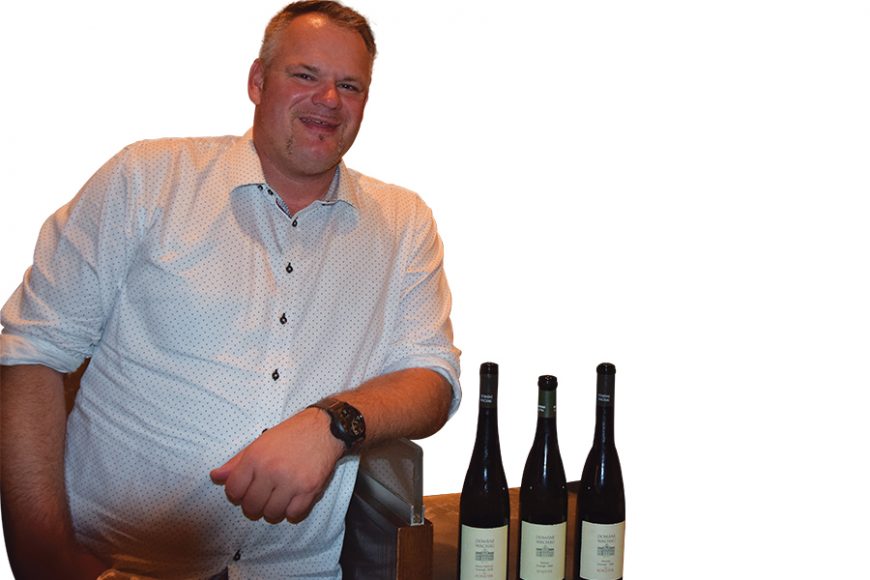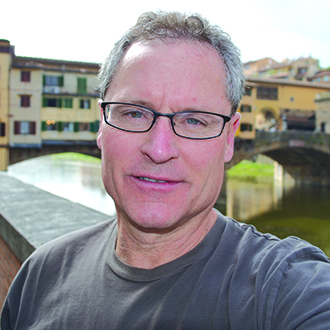How nice it must be to establish a vineyard in a farmland-type setting in wine country where lush acreage allows vineyard rows to be perfectly straight and the trellising stakes line up on the 45 degree bias from two directions. And how simple it must be to engage a large grape picker for a quick harvest when conditions are optimal. Perhaps winemaker Heinz Frischengruber from Austria’s Domäne Wachau dreams of this simplicity, but it is not his reality. I recently met with Frischengruber over a wonderful dinner at Charlie Palmer’s midtown restaurant, Aureole, and had an evening to dive into Austria’s Danube River region and what it brings to the world of wine.
Domäne Wachau (pronounced “va cow”) is a cooperative winery on the banks of the Danube, Europe’s second-largest river. The 250 grape growers that contribute to Domäne Wachau work impossibly steep terrain, most of it terraced by rustic walls, each tier supporting only one or two vines rows. No power equipment can access the stony steeps, so every vineyard detail is performed the old-fashioned way. From the air, the vineyards are not precise and orderly. Rather the vines follow the contours of the rocky crags, abutments and centuries-old manmade terraces, where all the producers are sustainably certified to work with nature for an unmanipulated, pure expression of what flavors the stone and terroir will emit.
Many of the vines grow in just 15 centimeters (just under six inches) of topsoil on granite, schist, gneiss (pronounced “nice) — the stuff Manhattan Island is made of — and marble. This bedrock base, along with all the terracing retaining walls, leaches a minerality, a clean unmistakable stoniness to the grapes that will make wines of elegance and purity. This rocky region is also a UNESCO World Heritage Site, for its natural beauty as well as its cultural and historical contributions to humanity.
Frischengruber grew up amid his father’s winery, learning the business at an early age. He went on to oenological school in Austria and took jobs in different wineries in different regions of the world, honing his skill set. Then Domäne Wachau was looking for some winemaking talent and they found each other. He oversees the mostly small vineyards of 250 independent growers, spending an abundance of time between the rows of grapes to monitor the development to maximize flavor. The vineyards now have an ample green cover between the rows to encourage beneficial insects and plants to allow for a healthy ecosystem with biodiversity. Frischengruber decides when to harvest and begin the winery magic.
Grüner Veltliner is one third of all the Austrian wine production and Domäne Wachau’s are wonderful. It makes an entry level 2018 Gruner Veltliner Federspiel Terrassen. Look for green apple, pear and white pepper with a light spicy elegance. At $18 retail, you can’t go wrong. The next GV we tasted was a single vineyard Federspiel Ried Liebenberg ($25) from 2018, showing elegance with citrus, lemon zest, tart apple and white peach. Our third GV was from what Frischengruber called “The best single vineyard in all of Austria.” Smaragd is the top category for Wachau wines so look for that on the front label. This 2016 GV Smaragd Achleiten was a hit. At $46, it was fresh and lively, emitting citrus, white peach, herbs and white pepper notes. No oak is used in these wines. The production method is mostly in stainless steel tanks but they are experimenting with amphorae and concrete egg-shaped fermenters, which allow for more natural movement within the tank.
Frischengruber told me, “Grüner Veltliner was always the drinking wine. But Riesling was the contemplative wine.” We tasted three beautiful Rieslings spanning the decades, and it was wonderful. Our first, the fresh 2018 Domäne Wachau Riesling Federspiel Terrassen is the entry level wine but offered flavors of peach, pear and apricot. The 2018 Federspiel Ried Bruck ($25) showed wet stone and pronounced clean citrus with green apple. Next, from that “best single vineyard in Austria” we were in for a treat. We tasted a Smaragd Achleiten from 1996 ($95), which showed how beautifully Rieslings mature. All of these wines can be opened at vineyard release and they are lovely, but time in the cellar will improve the Grüners noticeably and the Rieslings radically. This wine showed that classic salty, citrus Riesling-ness, with stone fruit, citrus blends of lemon and tart orange carried by river stone flavors. Every swirl and taste of this wine emitted additional flavors to identify and enjoy. Look for these wines and switch up the routine. Gneiss vineyards make gneiss wines. So nice.
Write me at doug@dougpaulding.com.


